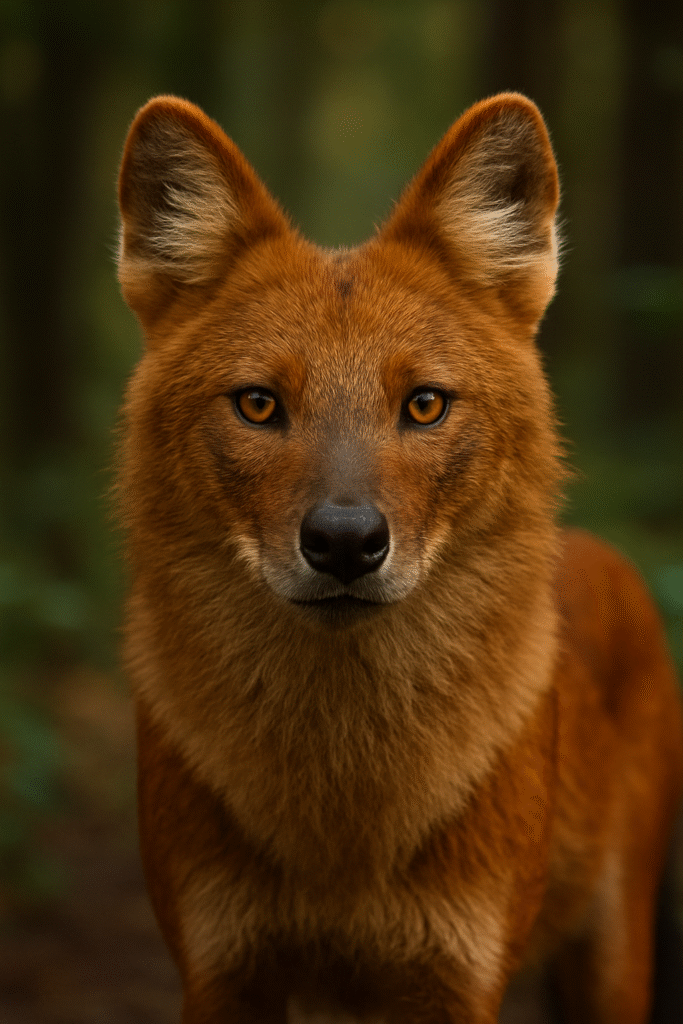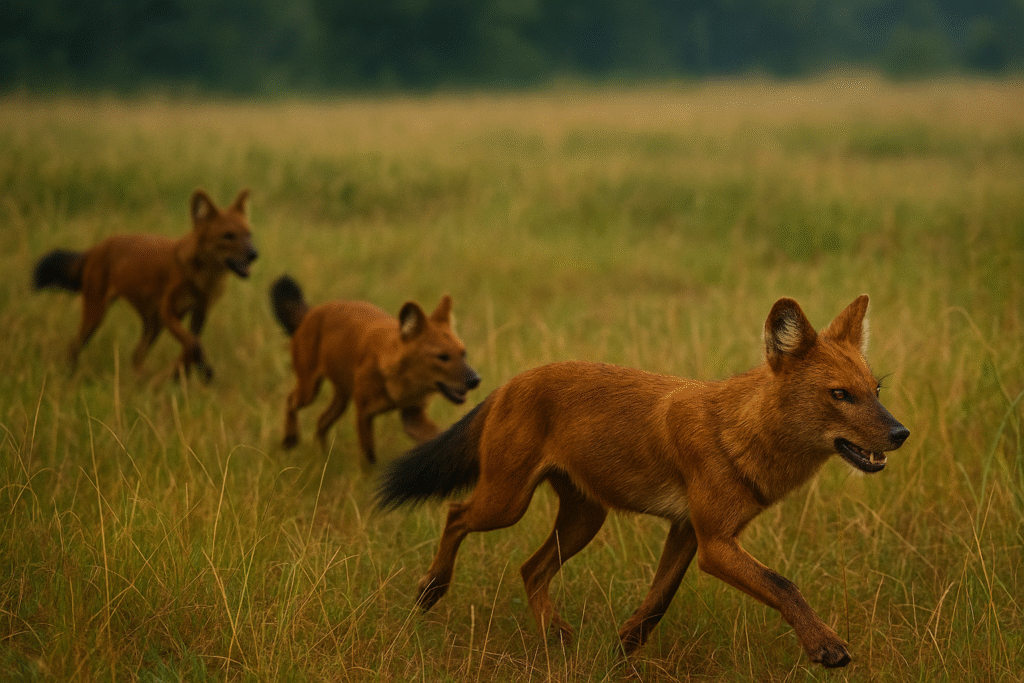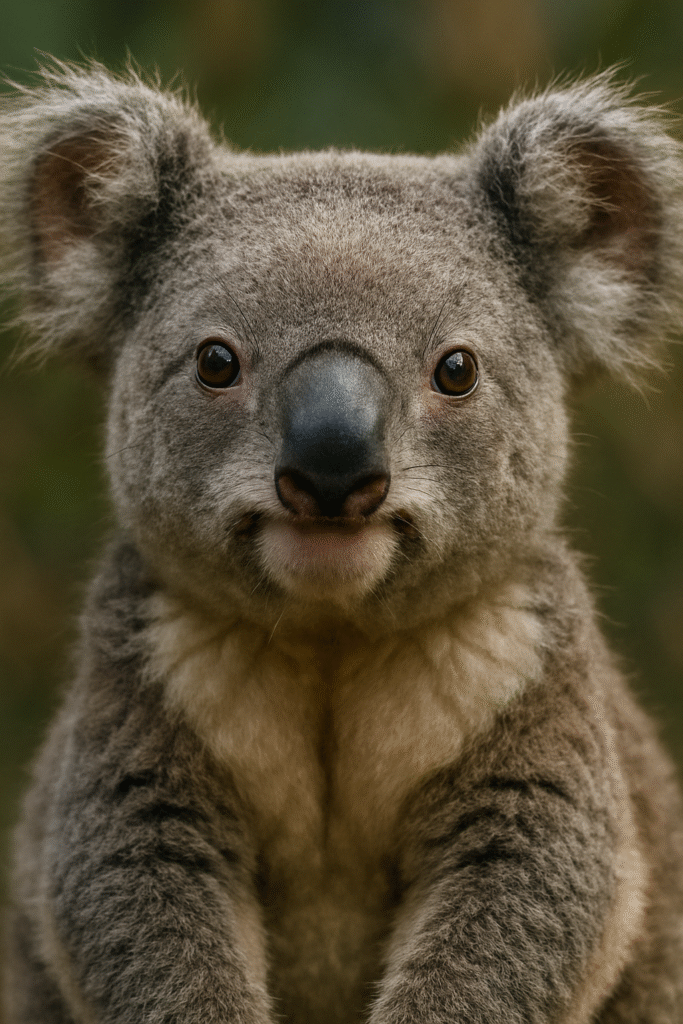In the grand theater of Asia’s wilderness, most audiences know the stars—tigers, leopards, elephants, and bears. Yet moving quietly in the margins of these forests is an animal every bit as captivating, though rarely given the recognition it deserves: the dhole (Cuon alpinus), also called the Asiatic wild dog, whistling dog, or red dog. To encounter one is rare; to hear its bird-like calls echoing across valleys is to brush against something both ancient and uncanny.

This is the story of a predator whose survival depends not on sheer size, but on community, persistence, and silence.
The Dhole’s Appearance: A Fox, a Wolf, and Something Else Entirely
At first glance, the dhole looks like a fox enlarged or a wolf reshaped: reddish-brown fur fading to cream underbelly, tufted ears, and a bushy tail tipped in black. Adults weigh between 26 and 44 pounds—far smaller than the tigers and leopards they share their lands with. Yet the dhole’s build is a blueprint for endurance: lean muscles, long limbs, and lungs built for stamina rather than speed.
Its face holds a curious balance: the gentle softness of a fox’s muzzle paired with the watchful intensity of a wolf’s stare. But what truly sets it apart are its eyes—amber, piercing, almost luminous when caught by shafts of sunlight.
Life in the Pack: Whistles in the Forest
The dhole is never truly alone. Packs range from 5 to 20, sometimes swelling to over 30 in rich forests. Unlike wolves, which rely heavily on howls, dholes speak in a secret language of whistles, yelps, and chatters. These sounds, high-pitched and bird-like, cut through dense jungle, allowing them to fan out over great distances and regroup in seconds.
Scientists still struggle to decode this vocal system, but what is clear is that it is unique among canids. In fact, locals once believed that the forest itself whispered through the dholes, giving rise to the name “whistling dog.”
The pack is a democracy of movement. While alpha pairs exist, dholes thrive because of cooperation. They feed together, share pup-rearing duties, and even adopt pups orphaned from other groups. Their hunting method reflects this spirit: a carefully coordinated ballet of endurance, not ambush.
Masters of the Hunt
If the tiger is the jungle’s shadow and the leopard its ghost, then the dhole is the long chase. Unlike ambush predators, dholes rely on stamina. Packs may pursue sambar deer or wild boar for kilometers, harassing, circling, and wearing down prey until exhaustion tilts the balance.
Remarkably, dholes have been observed driving tigers and leopards from their kills—an astonishing feat for animals half their size. This boldness, however, is not recklessness; it is the quiet confidence of numbers.

Their diet is varied—ungulates when available, but also smaller mammals, lizards, and even fruit when prey is scarce. In ecosystems where they thrive, dholes act as ecological regulators, preventing overpopulation of herbivores and maintaining the delicate balance of forest and grassland.
A Predator on the Brink
Despite their skill, dholes are classified as endangered. Once widespread across Asia—from Siberia to the southern tip of India—they are now confined to fragmented pockets. Fewer than 2,500 mature individuals are believed to survive in the wild.
The reasons are painfully familiar:
- Habitat loss from agriculture, logging, and infrastructure.
- Prey depletion as deer and wild boar are hunted unsustainably.
- Persecution from farmers who view them as threats to livestock.
- Diseases like distemper and rabies, transmitted from domestic dogs.
Unlike tigers or elephants, the dhole lacks the charisma that draws global conservation funds. For decades it was dismissed as vermin, a pest to be eliminated rather than protected. In colonial India, hunters were paid bounties for killing dholes, leading to dramatic population crashes.
Today, its survival depends on the protection of strongholds like India’s Western Ghats, Nepal’s Terai, Bhutan’s mountains, and the forests of Thailand and Myanmar.
The Dhole in Myth and Memory
In folklore, the dhole is both feared and revered. In Chinese texts, it was described as a relentless pack-hunter, said to strip tigers of their prey. In Indian myths, it appears as a trickster, a forest spirit whose whistles could guide or mislead travelers.
For villagers, dholes have long existed at the edge of imagination: too rare to know intimately, too vocal to ignore. Their whistles became omens; their sudden appearances, signs of shifting fortunes.
This duality—part ghost, part guardian—reflects humanity’s broader struggle to define our relationship with predators: admiration mingled with fear.
Lessons from the Whistling Dog
What makes the dhole extraordinary is not its teeth or claws, but its philosophy of survival. It reminds us that:
- Strength is collective. Alone, a dhole is vulnerable; together, the pack thrives.
- Power need not be loud. Where wolves howl and lions roar, the dhole whispers and whistles.
- Persistence outlasts brute force. In a world of ambush predators, it wins by outlasting.
To study the dhole is to study resilience—how a modest creature endures in a world that rewards spectacle.
A Future Still Possible
There is hope. Community-led conservation programs in India and Bhutan are beginning to change attitudes. Eco-tourism has brought new value to seeing dholes alive rather than dead. Protected corridors linking fragmented forests may yet secure their survival.

But the dhole’s fate hangs in balance. If it disappears, Asia will lose not just a predator, but an ancient story-teller of the forest—a reminder that survival is not about dominance, but about cooperation, patience, and unseen strength.
Final Reflection
The dhole moves through the forests as a shadow within shadows. It will never command the world’s stage like the tiger or elephant, but perhaps that is its greatest lesson. The forest is not only about the visible giants—it is also about the unseen threads that hold the whole together.
The dhole is one such thread: a creature that endures not by conquering, but by belonging.
And in its whistles, echoing through the twilight of Asian jungles, we are invited to listen—not to fear, not to silence, but to a language older than our own.


Reply